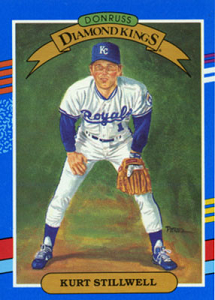As you may have noticed, the Kansas City Royals jumped out to a very fast start in 2011, and while they’ve fallen off recently and are at 20-20, they finally seem poised to take a big step forward. There is a sense of optimism in Kansas City again, a sense that the future really will be brighter. And that’s crucial for a team that hasn’t made the postseason since their World Series win in 1985.
Some will point to the bevy of young prospects the Royals are on the verge of graduating to the Big Leagues. Some will point to surprisingly cagey free agent pickups like Jeff Francoeur, Melky Cabrera, and Bruce Chen. Some may even point to improved chemistry with Zack Greinke gone. But they would be wrong. For The Common Man has uncovered the real reason the spectre of 25 seasons of futility has been lifted from Royals’ shoulders. Rejoice! For the Curse of Tony Ferreira has been lifted! Observe:
 |
| The Curse of Tony Ferreira Click to embiggen |
 |
| What Tony Ferreira can do for you. |
Not wanting to sit on their laurels, the Royals tried to upgrade that offseason. Realizing they had a giant hole at SS (Royals SSs had hit .204/.263/.253, a 47 OPS+), the Royals dealt Ferreira at the end of Spring Training to the Mets for Angel Salazar, another good field/no hit SS. Salazar would hit .224/.242/.285 (a 40 OPS+ in two years as a Royal, and the club could not build off its success. Of course it couldn’t. Ferreira took their mojo with him to Queens, where it helped the Mets win the 1986 Series, though Ferreira would not pitch in the Majors that year (or ever again, actually). In the ensuing seasons, the Royals would go 1799-2180, with a .452 winning percentage, and never taste the postseason.
Salazar was packaged with disappointing lefty Danny Jackson in 1987 to the Reds for the awesomely named Ted Power and Kurt Stillwell, a former 1st round choice (2nd overall) who was well regarded, but was never going to be able to unseat Barry Larkin as the starter in the Queen City. Jackson immediately became a Cy Young candidate in Cincinnati, winning 23 games in 1988. Power lasted less than a full season and had a 5.94 ERA in powder blue before being dealt for a couple prospects. He was converted back to a reliever, and had four more strong seasons in him. One of the prospects, Mark Lee, was actually a pretty nice looking reliever, who could have bolstered KC’s pen. But they tried to make him into a starter. He had a 5.21 ERA at AA Memphis and was released. He caught on with Milwaukee, who reconverted him into a reliever and immediately got a year and a half of strong relief out of him.
 |
| Seriously? A Diamond King |
With the other pick, 1.35, the Royals took a speedy young outfielder out of Florida named Johnny Damon. Damon flew through the minors and was called up in August of 1995, just 21 years old, and would stay in the Majors for the rest of his career. The Royals held on to him and let him develop, and he formed a strong young outfield with Jermaine Dye and Carlos Beltran from 1999-2000. All of them would be dealt for prospects (and all of them, incidentally, were pretty bad deals), but Damon left first, beginning his career as a nomad.
In January, he was sent to Oakland in a three team deal that netted the A’s Damon, Mark Ellis, and Cory Lidle. The Royals got back closer Roberto Hernandez, catcher AJ Hinch, and shortstop Angel Berroa. Hernandez had a 117 ERA+ and 54 saves across two seasons for a club that won just 39.2% of its games. Hinch hit .214/.285/.374 across two seasons as a backup catcher. Berroa managed to win Rookie of the Year in 2003 on the back of his .287 batting average and middling power (17 homers). But he also walked just 29 times (a career high) in 635 plate appearances. He was never as good again, and after four sasons of diminishing returns, Berroa was finally benched and sent to the Dodgers for minor league infielder Juan Rivera in 2008.
Rivera made it as high as Hi-A Wilmington in 2010, but was released after posting a .146/.245/.157 line in 106 PAs. In seven seasons, his minor league line was .239/.291/.297. Frankly, the Royals are better off without him. Because his release opens the door for a younger, better Royals prospect and also finally, mercifully, cleanses the Royals of the last vestige of Tony Ferreira. Their demons now exercised, these Royals can finally look to the future with hope.

2 comments:
And here I thought their demons were exorcised when they fired their manager last year. Silly me! This is much more logical. heh.
The curse began when you beat the Jays, the best team that franchise ever produced. George Bell is having his revenge.
Post a Comment